| When the divemaster announced we would start the day with a dawn dive at Mellow Yellow, I was thrilled. Recollections of dive sites tend to blend together over the years, but this one remains clearly defined by a previous dive in which we found a huge yellow frogfish nestled amid squat yellow sponges, surrounded by a field of saffron soft corals. I recall thinking at the time that they certainly nailed the name of the site. From my 2004 trip log: |
At Mellow Yellow we were briefed on the possibility that we might find a large yellow frogfish, and sure enough it was right where we were told it would be. Larger and more vibrant than most of its Caribbean cousins, this frogfish was nicely situated amid some red and yellow encrusting sponges. However, as satisfying as this encounter was, the marquee attraction of this dive is the yellow soft corals that adorn the main pinnacle and the saddle that adjoins it to a smaller, deeper pinnacle nearby. This is the dive for which Velvia slide film was made: gold anthias, yellow soft corals, crimson sea fans and turquoise water. I was blown away on this dive — not literally, which is possible in the heavy current sometimes present here, but figuratively, in astonishment. We dived Mellow Yellow again later in the week at a time when the currents were not as propitious. There was no flow whatsoever, and the dive was therefore totally different — good, of course, but the right amount of current transforms the merely good into amazing in these waters.
Now, more than a decade later, I wondered if this site would still deliver. After all, it is a pinnacle, and some of the pinnacles I’m seeing in other parts of the world are showing signs of wear. This degradation isn’t necessarily from divers touching the coral, but as dozens of divers circumnavigate popular pinnacles every day, their exhaust bubbles percolate upward and scrub the soft corals above. We may aspire to take only pictures and leave only bubbles, but on sites with vertical walls, overhangs or pinnacles, the bubbles may cause damage.

With that in mind I expected to find this site diminished from my previous perceptions. Yet 11 years later, in a mild current (enough to supersize the soft corals but not so much as to make it difficult to stay in place to frame a photo) this remains a world-class dive.
Photographers typically dive this site with a wide-angle lens; this day I concentrated on medium-sized fish portraits simply because the backgrounds were so rich, textured and colorful. While my yellow frogfish was unsurprisingly absent, the rest of the site was as pristine as ever. Revisiting the site was an epiphany, a testament to the healing waters that constantly flow through this place, the soft coral capital of the world. The fact that I was jumping into the water here so soon after leaving Los Angeles is insight into something notable about Fiji diving: It is so very good and so very near.
Unlike some exotic dive destinations, which can involve 40-hour treks and hotel stays en route, Fiji is blessedly accessible to North American travelers. From Los Angeles International Airport, Fiji’s main island, Viti Levu, is a direct, 11-hour flight away. The port of departure for our liveaboard was just another two- to three-hour bus ride from the Nadi International Airport. Leaving LAX at midnight and gaining some hours by chewing through time zones along the way allowed us to settle into our cabins, prep our cameras and actually get into the water on the very first day of the charter.
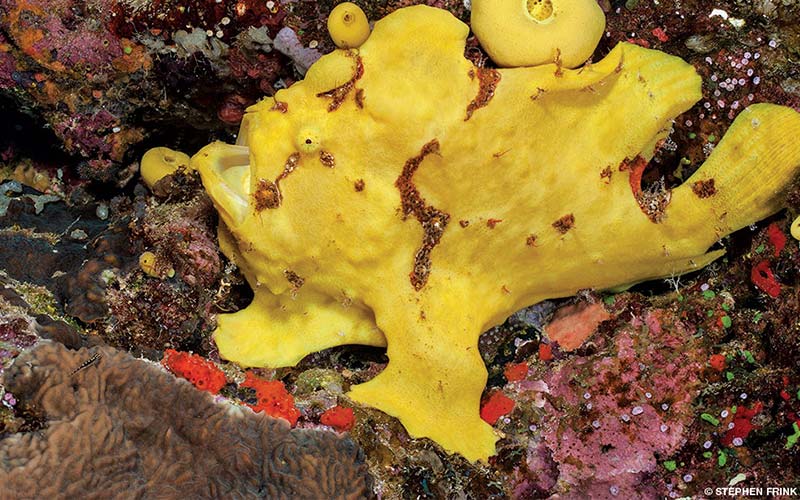
Cruising the Vatu-I-Ra Passage
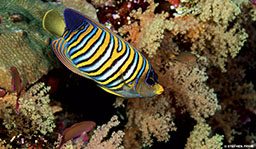
The first dive on many cruise itineraries, the dreaded checkout dive, is quite often fairly marginal. These tend to be close to shore and offer a shallow bottom so guests can refresh rusty skills and dial in buoyancy on a reef sufficiently devoid of life that an errant bump won’t matter. True to our expectations, this dive was the least impressive of those we did, but that was only because of the poor water clarity from days of rain pouring into the near-shore waters. The dive itself had potential for greatness.
At Amazing Maze, the amazing part was the series of tunnels rimmed by soft corals and a profusion of anthias, lionfish and clusters of anemones and clownfish. It would have been stunning but for the detritus and particulate matter that had washed onto the reef from nearby Viti Levu. With a 100mm macro lens mounted, I was perfectly happy to concentrate on reef minutiae. However, the songs of an obviously nearby humpback whale kept making me look up in expectation of the ultimate photographic frustration: a friendly whale, crappy visibility and a macro lens on my camera. I guess I was lucky I never saw a whale so I could avoid that angst.
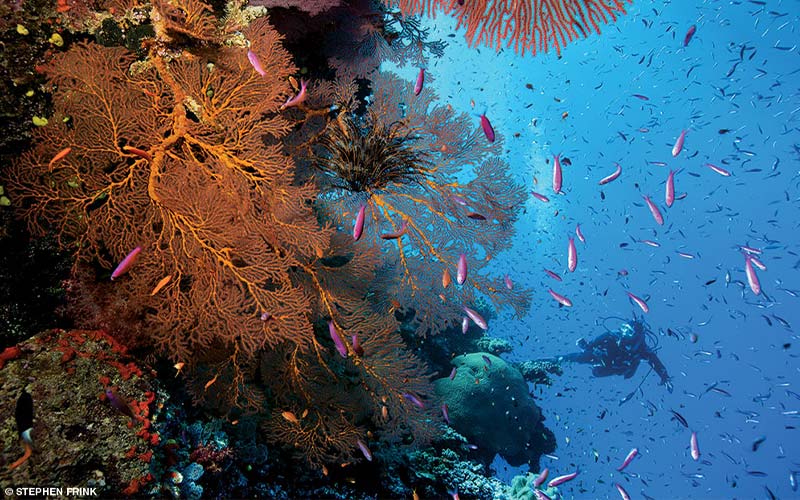
Seeing what the near-shore reefs delivered made it all the more special to jump into the 150-foot visibility at Mellow Yellow the next morning after an overnight steam to the Bligh Water in the Vatu-I-Ra Passage. We weren’t in Kansas anymore (but we’d be going there later).
The Bligh Water is named for William Bligh, who in 1789 found himself exiled from command of the HMS Bounty by master’s mate Fletcher Christian and a crew of 18 mutineers. Bligh and 18 loyal crewmembers were set adrift in a 23-foot launch to embark on a 3,600-mile journey to the Dutch port of Timor. Fear of cannibalism convinced Bligh not to dawdle in these waters, but dawdling here for the next 10 days was exactly what we had come to do.
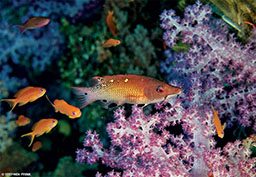
After spending our first full day of the charter alternating among Mellow Yellow, Black Magic Mountain and Coral Corner, we steamed overnight to sample dive sites off the island of Makogai. My first dive was at a site known as Half Pipe. It would have been quite productive if for no other reason than the giant crimson gorgonians that adorn the face of the drop-off, all densely populated with small reef dwellers such as fusiliers and anthias. But I was fortunate to find an incredibly docile hawksbill turtle swimming along the wall, weaving beneath and between the abundant filter feeders. Of course there were the other usual reef suspects: titan and clown triggerfish, puffers, whitetip reef sharks, goatfish, clownfish and schooling Moorish idols. There were smaller creatures for the macro enthusiasts such as longnosed hawkfish, popcorn shrimp and leaf scorpionfish. This was a very fruitful dive that we would revisit by request later in the cruise.
After spending the day diving the nearby sites Ratu Ridge and Dominoes, we visited a village on the island of Makogai, a former leper colony. Before more humane treatment for leprosy became the norm, lepers sometimes were clubbed to death. When Fiji became a British colony, clubbing was outlawed, and the Leper Ordinance Act of 1899 addressed the contagious nature of the disease by preventing the infected from handling food for the public or bathing in public pools. In 1908 the government isolated the country’s lepers at Makogai Island, and in 1911 nuns from the Missionary Sisters of the Society of Mary, along with a doctor who was the bishop in charge, arrived to care for the lepers. Other Pacific countries started sending their leprosy patients to Makogai, leading to a population of 675 patients on the island in 1947. The ratification of dapsone use at the International Conference on Leprosy in 1948 brought a steady decline in the number of leprosy cases, but not before more than 1,000 souls had been buried on Makogai.
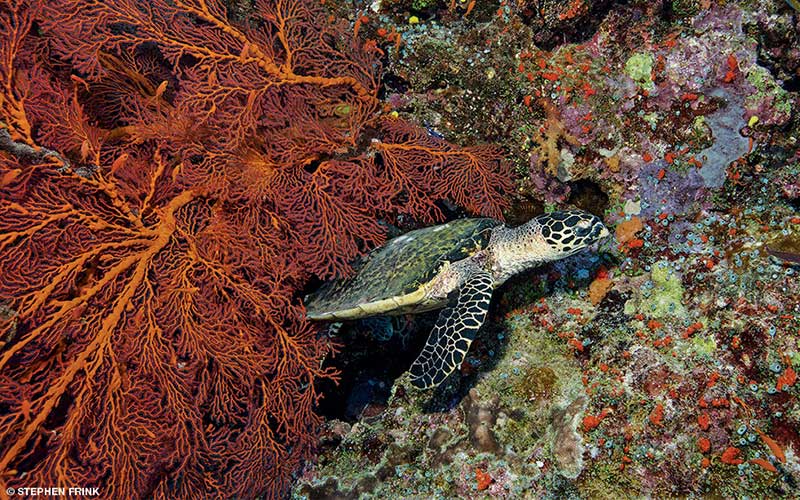
A walk among the graves and remnants of the leprosarium was sobering, but afterward the village children put on a joyous dance for us. A convivial kava ceremony hosted by the village elder prior to the dance might have facilitated the happy atmosphere, although I’ve never actually acquired a buzz from drinking kava. The beverage is a grog made by grinding the root of the kava plant and straining it with water into a large communal bowl. The ceremony of drinking the muddy concoction from a coconut shell is an integral part of the Fiji experience, and one the village at Makogai shared with great hospitality.
Taveuni
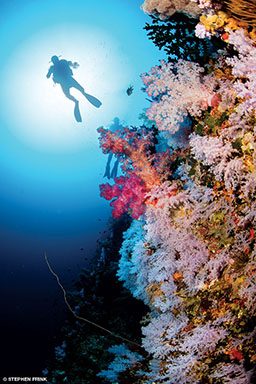
Surprisingly, in six previous trips to Fiji I’d never been to one of its most iconic islands, Taveuni. The fourth largest islands in Fiji, and connected to the outside world with its own international airport, the “Garden Island” offers a sophisticated infrastructure of dive resorts specializing in mythic dive sites. While we were diving from a liveaboard this trip, I look forward to a land-based dive trip here as well. The diving was exceptional, and we often saw the day dive boats from Taveuni cruising to their moorings. A friendly wave was about all the interaction we had with them though, for there are ample sites available to all.
Never having been to Taveuni, I’d not dived one of Fiji’s most famous sites, the Great White Wall, an omission I was eager to rectify. According to the briefing, we would descend through a semilong tunnel and exit at about 80 feet before turning left and cruising along the reef wall. Almost immediately we encountered an area of the wall that could be described as both “great” and “white.” When the current rips (which it clearly does at times, as evidenced by the density and diversity of soft corals) you might swim past the lushest portion of the dive without meaning to and won’t be able to swim back against the current to see it again. You might also be surprised to see that the white soft corals aren’t nearly as immense as the red, yellow or lavender soft coral trees you may have seen elsewhere. But the sheer multitude of them along this wall is most impressive. Don’t despair if you are blown off the wall too soon, because the rest of the dive is likewise decorated by impressively vibrant soft-coral-festooned reefs.
One of the nice things about diving from a liveaboard that visits the same sites week after week is that the crew tends to know where to find creatures of significance. This is particularly true for territorial or sedentary species such as pygmy seahorses and blue ribbon eels, a subject I was interested in photographing.
I’m fortunate that many of my charter guests are repeat customers. A guest on this Fiji tour has an infallible memory, and whenever the subject of blue ribbon eels comes up she is sure to remind me, “My best shot of a blue ribbon eel never happened because when we were in Fiji in 2004 we saw one at 80 feet, and by the time you were done photographing it, it went back into its hole and never came out before my bottom time was up.” On this trip I finally absolved myself of that long-lingering guilt by sharing with her a photo-op with a particularly bold blue ribbon eel in less than 30 feet of water at Jerry’s Jelly, a rich and productive shallow dive site off Taveuni. While the eels, of which we found three on a small patch of reef, might have been the target species for that particular dive, the ship’s log confirmed guest sightings of whitetip reef sharks, scorpionfish, garden eels, whip gobies, Maori wrasses and fire dartfish.
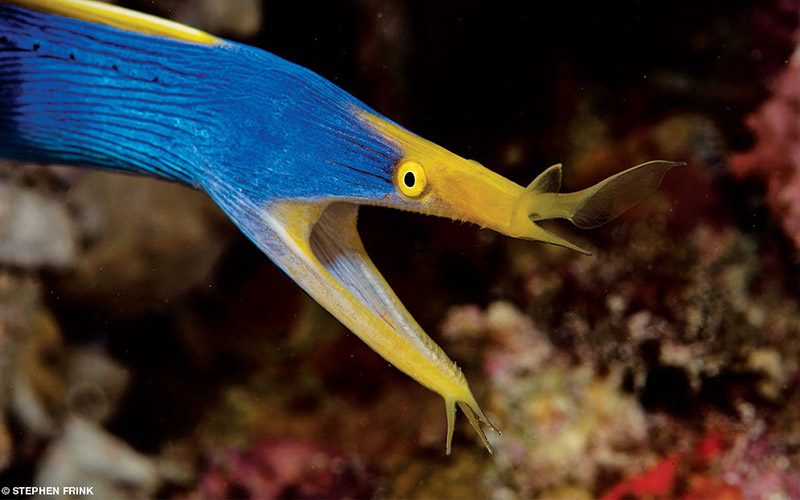
Namena Marine Reserve
The Namena Marine Reserve surrounds the tiny island of Namenalala and stretches between the two main islands of Fiji: Viti Levu and Vanua Levu. Established in 1997, it encompasses approximately 30 square miles and bans commercial fishing within its boundaries. Like so many marine protected areas, the Namena MPA pays massive dividends in terms of quality dives.
One of my consistently favorite dives in all of Fiji is found in North Save-A-Tack Passage at a dive site that encompasses both The Arch and a shallow plateau called Kansas. The latter site’s tan leather corals must have reminded someone of Great Plains wheat fields. We dropped in at The Arch, a lovely wide-angle background worthy of a visit on its own, knowing there was a resident school of chevron barracuda and jacks that cruise the edge of the drop-off. For whatever reason, whether current flow or propinquity, the barracuda were swimming in a tightly polarized formation that day. With a slow and measured approach, I was able to fill the frame with dozens of fish when zoomed tight and scores as I zoomed wide.
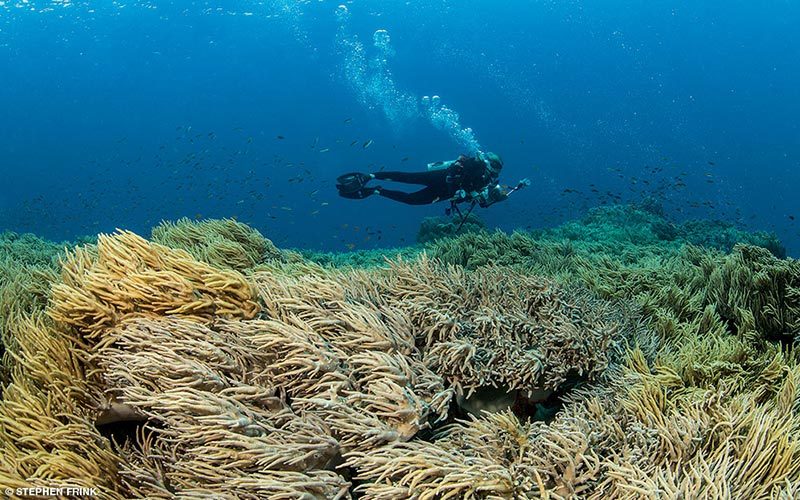
Jacks and barracuda are subtle variations of blue and silver; but swimming back to the reef I found color: An emperor angelfish, blissfully ignorant of my proximity, foraged amid the soft corals that decorated the base of The Arch. From there, a short swim along Yellow Brick Road culminated in the dense concentration of leather corals at Kansas. Adjacent to Kansas is the oft-photographed Window of Dreams, notable for the profusion of soft corals that surround a portal in the reef, just the right size for framing diver portraits.
Although so much is so good in the depths of the Namena Marine Reserve, you should save a little time at the end of the dive to explore the tops of the bommies. The hard-coral formations in the shallows are often quite extraordinary, as I experienced in a series of photos from a 2012 expedition there.
To spend a bit more time in Taveuni, we opted not to dive Nigali Pass on this trip. This was a very tough call, and it might have been the first time I’ve ever missed a shark dive on purpose. I revisited previous trip logs to recollect this iconic Fiji drift dive. The pass is a long channel that features almost certain encounters with horse-eye jacks and chevron barracuda. Once divers arrive, bait is strategically placed on the portion of the reef the crew calls “the bleachers.” Red sea bass swarm the bait so eagerly that I think it makes the gray reef sharks hang back a bit. But the sharks come within camera range — 3 to 5 feet away, typically. The site features a large, scenic patch of lettuce coral in very shallow water, which provides an interesting place to offgass at the end of the dive.

This 10-day expedition featured many other dives of significance, one of which I hadn’t visited since the beginning of the digital era, which for me was 2001. I guess it is appropriate that the site is called E6, named for the chemical process used for developing certain transparency films, and last time I was there I was shooting Fujichrome Velvia in a Nikonos V. This time I was using a 50-megapixel Canon EOS 5DS, and happily I had far more exposures than the 36 that film had allotted. The ship’s dive log indicated that those who were on a quest to photograph marine life on this dive saw schooling jacks, gray reef sharks, Moorish idols, clown triggerfish and the ubiquitous regal angelfish. With my fisheye lens better suited to large reef scenics, I ignored the reef dwellers and concentrated on the immense soft-coral-decorated foreground, while shafts of light pierced The Cathedral. Here a narrow opening in the reef above allows sunlight to penetrate, giving an almost laserlike quality to the backgrounds.
It was particularly satisfying that a dive site I’d first experienced using the photo technology of the past is still so good when revisited with the latest imaging tools of 2015. That is somehow emblematic of the Fiji dive experience. The minimal visitation and the maximal nutrients that continuously drift along these reefs provide some insulation from the passage of time.
How to Dive It
Getting There: Fiji lies in the southwestern Pacific, 1,750 miles northeast of Sydney, Australia. The 333 islands of the archipelago are spread over 80,000 square miles of ocean. The islands of Viti Levu, Vanua Levu and Taveuni make up 90 percent of the nation’s landmass and are home to 85 percent of its 880,000 people. Several airlines offer flights from Los Angeles to Nadi, including American, Fiji Airways, Qantas and Air New Zealand.

Land-Based or Liveaboard? Our 2015 itinerary included some sites accessible only via liveaboard dive boat because of their distance from shore, but Fiji has dozens of extraordinary land-based dive resorts that offer high-quality diving with daily dive excursions and sophisticated scuba infrastructure.
Water Temperature: Divers are sometimes surprised by how cold the water is in Fiji at certain times of year. It’s certainly not frigid, but in September through November it might drop into the low- to mid-70s°F. Dress for it, and you’ll have a wonderful time. In September 2015 the temperature was typically right around 75°F throughout our cruising range. I’ve been there in February and had 86°F water. In some months a 3mm wetsuit is plenty, but in others a 5mm to 7mm wetsuit might be advisable. With four dives per day the norm on liveaboards, be sure to pack sufficient thermal protection.
Current: Many dive profiles bottom out around 80 feet and involve gradual ascents along consistently scenic walls or pinnacles. Though currents are not always present, ability to manage them is important. Depending on where you went and how your dive operator timed your drops, you could dive here for a week and never feel current, but you wouldn’t see the best of Fiji that way. A bit of flow is necessary to get the soft corals in their optimal feeding finery, and much of the pelagic action from sharks and mantas is directly dependent on current. Familiarity with drift-diving protocols and the ability to deploy a safety sausage are essential.
Visibility: Water clarity can be highly variable, depending on where in Fiji you dive. Proximity to rivers or other sources of freshwater runoff means reduced visibility. For the most part, assume good to great water clarity; 50 feet would be average for a near-shore reef, and this can climb to 150 feet on offshore reefs and pinnacles.
Hyperbaric Chamber: There is a chamber in Fiji’s capital city, Suva, on the main island, Viti Levu.
© Alert Diver — Q1 Winter 2016